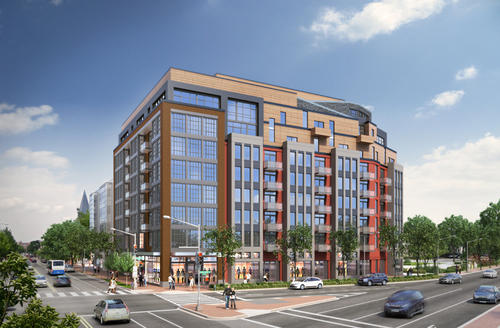Less parking needed for housing atop Metro, not more
The developer of a new residential building at 7th & R streets NW in Shaw plans just 40 parking spaces for 105 units, but ANC commissioners say it isn’t enough. Is more parking actually necessary?
Last year, DC put out a request for proposals to develop Parcel 42, a 17,000 square-foot lot next to the Shaw Metro station. After receiving several proposals, the Office of the Deputy Mayor for Planning and Economic Development selected the TenSquare Group, which wants to build 105 apartments and 5,000 square feet of retail space there. The developer will set aside 20% of the eight-story building’s units as affordable housing and expect it to meet LEED Silver standards, a measure of environmental sustainability.
The Zoning Commission has yet to approve the project. Neighbors and ANC6E commissioners are unhappy that the building would have just 40 parking spaces, located underground. TenSquare insists that the current plan maximizes the motor vehicle parking for a building its size, but it’s unclear how much of the parking will be set aside for retail customers.
At a meeting last Wednesday, commissioners insisted that TenSquare add more parking spaces before they could support the project. Kevin Chapple, the Advisory Neighborhood Commissioner whose single-member district covers Parcel 42, and fellow commissioners threatened to oppose the project at the Zoning Commission unless there was more parking.
Chapple owns a home three blocks away and relies on street parking. Not surprisingly, he and his neighbors want to ensure that there is enough space for their cars. But this building may not have a big impact on that. After the Howard Theatre opened last year, DDOT decided to include Shaw in its initial launch of the Visitor Parking Pass program.
Parcel 42 is also next to the Shaw Metro station, and several Metrobus lines run up and down 7th Street in front of the proposed building, including the 70, 79, and G8. There are also several Capital Bikeshare stations nearby. Meanwhile, there’s a lot to walk to nearby. Shaw has seen a tremendous boom in corporate, retail, and restaurant development. In fact, Mayor Gray will take part in ribbon cuttings for three restaurants in Shaw later this week.
It’s because of compact, walkable neighborhoods like Shaw that DC residents led the regional trend in driving less. According to COG, DC residents drove 8% less in 2011 than they did in 2005. While the city has added 40,000 residents in the past decade, the number of car registrations has remained flat, suggesting more people are choosing to live without owning a car. It’s likely that a new building at Parcel 42 will attract car-less residents, both to market-rate and affordable units, as less affluent households tend to have lower rates of car ownership.
Shaw has not seen the traffic congestion that other parts of the city experience. But that may soon change with the completion of developments like Jefferson at Market Place, CityMarket at O, and smaller projects, many of which will have much more parking than Parcel 42 and are likely to attract more cars.
The Jefferson development will include 281 apartments, 13,400 square feet of retail space, and 230 below-grade parking spaces. CityMarket will have 645 residential units, 182 hotel rooms, and 86,239 square feet of retail, along with 500 parking spaces. Roadside Development, which is building that project, originally planned for 700 parking spaces. Because it’s in such a transit-accessible location, city planners asked for less parking, despite complaints from community leaders.
Mayor Vincent Gray has repeatedly suggested that as the District’s population increases, the city will not be able to accommodate similar increases in motor vehicle ownership and traffic. The developers of Parcel 42 already seem to have accepted this reality. More homes and amenities within close reach of each other means fewer car trips, not more, and we should plan for parking accordingly.
I grew up in California, the heart of American car culture, but carpooled or took transit to high school and university, fighting two or three hours of congestion each way. I’m not unfazed by the growing pains DC is facing, but I am surprised it’s taken so long for local leaders to address them.
This article was edited to note that this project has not yet been approved and that the Zoning Commission, not the Office of Planning, will decide to approve it.

